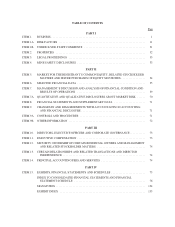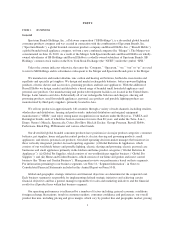Rayovac 2012 Annual Report Download - page 19
Download and view the complete annual report
Please find page 19 of the 2012 Rayovac annual report below. You can navigate through the pages in the report by either clicking on the pages listed below, or by using the keyword search tool below to find specific information within the annual report.We have been, and in the future may be, subject to proceedings related to our disposal of industrial and
hazardous material at off-site disposal locations or similar disposals made by other parties for which we are held
responsible as a result of our relationships with such other parties. In the U.S., these proceedings are under the
Federal Comprehensive Environmental Response, Compensation and Liability Act of 1980 (“CERCLA”) or
similar state laws that hold persons who “arranged for” the disposal or treatment of such substances strictly liable
for costs incurred in responding to the release or threatened release of hazardous substances from such sites,
regardless of fault or the lawfulness of the original disposal. Liability under CERCLA is typically joint and
several, meaning that a liable party may be responsible for all costs incurred in investigating and remediating
contamination at a site. As a practical matter, liability at CERCLA sites is shared by all of the viable responsible
parties. We occasionally are identified by federal or state governmental agencies as being a potentially
responsible party for response actions contemplated at an off-site facility. At the existing sites where we have
been notified of our status as a potentially responsible party, it is either premature to determine whether our
potential liability, if any, will be material or we do not believe that our liability, if any, will be material. We may
be named as a potentially responsible party under CERCLA or similar state laws for other sites not currently
known to us, and the costs and liabilities associated with these sites may be material.
It is difficult to quantify with certainty the potential financial impact of actions regarding expenditures for
environmental matters, particularly remediation, and future capital expenditures for environmental control
equipment. Nevertheless, based upon the information currently available, we believe that our ultimate liability
arising from such environmental matters, taking into account established accruals of $5.4 million for estimated
liabilities at September 30, 2012 should not be material to our business or financial condition.
Electronic and electrical products that we sell in Europe, particularly products sold under the Remington
brand name, VARTA battery chargers, certain portable lighting and all of our batteries, are subject to regulation
in European Union (“EU”) markets under three key EU directives. The first directive is the Restriction of the Use
of Hazardous Substances in Electrical and Electronic Equipment (“RoHS”) which took effect in EU member
states beginning July 1, 2006. RoHS prohibits companies from selling products which contain certain specified
hazardous materials in EU member states. We believe that compliance with RoHS will not have a material effect
on our capital expenditures, financial condition, earnings or competitive position. The second directive is entitled
the Waste of Electrical and Electronic Equipment (“WEEE”). WEEE makes producers or importers of particular
classes of electrical goods financially responsible for specified collection, recycling, treatment and disposal of
past and future covered products. WEEE assigns levels of responsibility to companies doing business in EU
markets based on their relative market share. WEEE calls on each EU member state to enact enabling legislation
to implement the directive. To comply with WEEE requirements, we have partnered with other companies to
create a comprehensive collection, treatment, disposal and recycling program. As EU member states pass
enabling legislation we currently expect our compliance system to be sufficient to meet such requirements. Our
current estimated costs associated with compliance with WEEE are not significant based on our current market
share. However, we continue to evaluate the impact of the WEEE legislation as EU member states implement
guidance and as our market share changes and, as a result, actual costs to our company could differ from our
current estimates and may be material to our business, financial condition or results of operations. The third
directive is the Directive on Batteries and Accumulators and Waste Batteries, which was adopted in September
2006 and went into effect in September 2008 (the “Battery Directive”). The Battery Directive bans heavy metals
in batteries by establishing maximum quantities of those heavy metals in batteries and mandates waste
management of batteries, including collection, recycling and disposal systems. The Battery Directive places the
costs of such waste management systems on producers and importers of batteries. The Battery Directive calls on
each EU member state to enact enabling legislation to implement the directive. We currently believe that
compliance with the Battery Directive will not have a material effect on our capital expenditures, financial
condition, earnings or competitive position. However, until such time as the EU member states adopt enabling
legislation, a full evaluation of these costs cannot be completed. We will continue to evaluate the impact of the
Battery Directive and its enabling legislation as EU member states implement guidance.
9
























